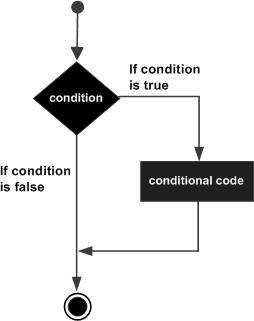
- 基本 Objective-C
- Objective-C - 主页
- Objective-C - 概述
- Objective-C - 环境设置
- Objective-C - 程序结构
- Objective-C - 基本语法
- Objective-C - 数据类型
- Objective-C - 变量
- Objective-C - 常量
- Objective-C - 运算符
- Objective-C - 循环
- Objective-C - 决策
- Objective-C - 函数
- Objective-C - 块
- Objective-C - 数字
- Objective-C - 数组
- Objective-C - 指针
- Objective-C - 字符串
- Objective-C - 结构
- Objective-C - 预处理器
- Objective-C - Typedef
- Objective-C - 类型转换
- Objective-C - 日志处理
- Objective-C - 错误处理
- 命令行参数
- 高级 Objective-C
- Objective-C - 类和对象
- Objective-C - 继承
- Objective-C - 多态性
- Objective-C - 数据封装
- Objective-C - 类别
- Objective-C - 摆姿势
- Objective-C - 扩展
- Objective-C - 协议
- Objective-C - 动态绑定
- Objective-C - 复合对象
- Obj-C - 基础框架
- Objective-C - 快速枚举
- Obj-C - 内存管理
- Objective-C 有用资源
- Objective-C - 快速指南
- Objective-C - 有用的资源
- Objective-C - 讨论
Objective-C - if 语句
if语句由一个布尔表达式后跟一个或多个语句组成。
句法
Objective-C 编程语言中 if 语句的语法是 -
if(boolean_expression) {
/* statement(s) will execute if the boolean expression is true */
}
如果布尔表达式的计算结果为true,则将执行 if 语句内的代码块。如果布尔表达式的计算结果为false,则将执行 if 语句末尾(右大括号之后)后的第一组代码。
Objective-C 编程语言将任何非零和非空值假定为true,如果它为零或null ,则将其假定为false值。
流程图

例子
#import <Foundation/Foundation.h>
int main () {
/* local variable definition */
int a = 10;
/* check the boolean condition using if statement */
if( a < 20 ) {
/* if condition is true then print the following */
NSLog(@"a is less than 20\n" );
}
NSLog(@"value of a is : %d\n", a);
return 0;
}
当上面的代码被编译并执行时,它会产生以下结果 -
2013-09-07 22:07:00.845 demo[13573] a is less than 20 2013-09-07 22:07:00.845 demo[13573] value of a is : 10
Objective_c_decision_making.htm